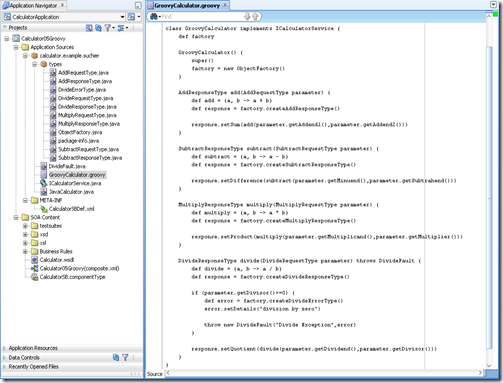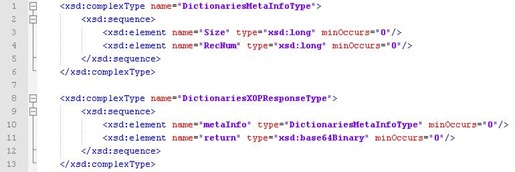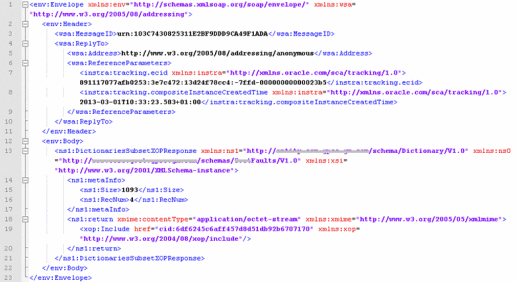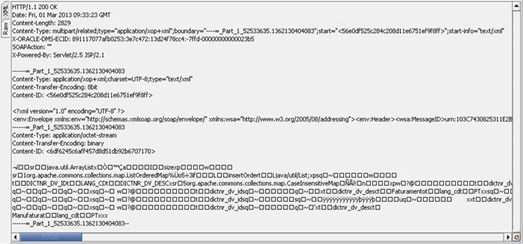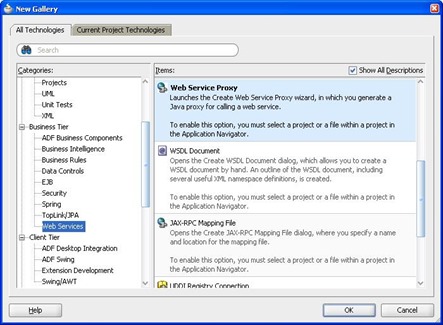Polyglot programming, defined most simply, is the use of multiple languages in software development. Implementing services on the SCA Container is already a intended polyglot development approach. Oracle SOA Suite have the SCA service implementation types of BPEL, Human Workflow, Mediator, Rule and Spring Components. These components are mixing the General-Purpose Language (GPL) Java with Domain-Specific Languages (DSL) like XSD, WSDL or Schematron. But Spring Components are also enabler of service implementations with other JVM GPL languages beside Java.
In my opinion Neal Ford was absolutely right when he coined the term “Polyglot Programming” and predicts “Applications of the future will take advantage of the polyglot nature of the language world … The times of writing an application in a single general purpose language is over” already in 2006. In order to produce polyglot implementations you need environments where polyglot-ism is required or at least encouraged. Oracle SOA Suite is such a polyglot supporting environment and you are doing polyglot development all the time (e.g. XML, WSDL, SQL, Java). But also on the GPL side the developers or not limited on Java. SCA Spring Components are supported since Patch Set 2 and the Spring Framework supports dynamic languages since version 2 (BeanShell, JRuby and Groovy).
Groovy is a General-Purpose Dynamic Language and has the best and seamless integration with Java (beside Spring integration Groovy supports also direct and JSR 223 integration). Therefore, using Groovy has a low threshold for Java developers; it is easy because Groovy has a Java-like syntax. Most Java code is also syntactically valid Groovy. So it’s an iterative learning approach for Java developers switching to Groovy. My first contact with Groovy was at the JAX conference in 2008. It was a Groovy newbie session from Dierk König (well-known book author of "Groovy in Action"). And for the first time in a long while of Java programming I had an awakening and still addicting interest on this development language.
The Groovy language is meant to complement Java and is adding a wide range of features that are sadly lacking in Java (for example Closures, Dynamic Typing and Metaprogramming – just to name a few). Concurrency and parallelism is increasingly important in the era of multi-core CPUs with a growing number of CPU cores. GPars is part of Groovy and offers a intuitive and safe way to handle tasks concurrently. Groovy makes it also easy to create DSLs (to simplify the “solution”). Optional parentheses, optional semicolons, method pointers and Metaprogramming let the code viewed as “executable pseudo code” (and easy readable by non-programmers). One of my personal favorites on using Groovy is the easy XML handling, both for consuming and producing XML content with its XML builders and parsers. Therefore I encourage you to take a deeper look on Groovy.
In my opinion Groovy envision also a bright future because the Spring development team announced to put a strong focus on Groovy on the upcoming Spring Framework 4.0. Spring 4 will about properly supporting Groovy 2 as a first-class implementation language for Spring-based application architectures - not just for selected scripted beans but rather for an entire application codebase, as a direct alternative to the standard Java language (quoting on Jürgen Höller from SpringSource who is the Spring Framework co-founder and project leader). The Spring Framework is the most popular application development framework for enterprise Java and will become therefore the driving force for getting more Java developers in touch with Groovy (and let them feel what is the “right language for the job”).
The latest version of Oracle SOA Suite (v11.1.1.7) comes with Spring v2.5.6 and has also the Groovy v1.6.3. libraries on board. These versions are outdated, because Spring v.2.5.6 was released in November 2008 and Spring is already on the 3.x version. Groovy v1.6.3 was released in Mai 2009 and Groovy is today on version 2.x. Anyway, since Oracle SOA Suite PS5 (11.1.1.6) it’s possible to do Spring Bean implementation using Groovy. Oracle itself is also using Groovy, for example the Rule Reporter is written in Groovy or Oracle ADF is using Groovy as well. But the official documentation on how to write SOA Suite Spring Beans with Groovy should be improved, because you need more details to make our polyglot implementation running. Motivating for using Groovy and showing the details are the reasons for this blog. Now lets go to the details.
First you have to do some configure steps. I show you the steps with the out-of-the-box coming Groovy library v1.6.3. But you also could download the latest Groovy version and make use of the newest Groovy features (I did a successful test with Groovy v2.1.3).
1.) Copy the $MW_HOME/oracle_common/modules/groovy-all-1.6.3.jar library to the $ORACLE_HOME/soa/modules/oracle.soa.ext_11.1.1 folder
You can add JAR files and custom classes to a SOA composite application. A SOA extension library for adding extension JARSs and classes to a SOA composite application is available in the $ORACLE_HOME/soa/modules/oracle.soa.ext_11.1.1 directory. The Groovy library has become known to SOA composite applications.
2.) Run ANT at the $ORACLE_HOME/soa/modules/oracle.soa.ext_11.1.1 folder
Running ANT on the "soa.ext" folder will update the oracle.soa.ext.jar library with a changed MANIFEST.MF file, adding a reference to Groovy.
Warning: This procedure is not cluster-friendly. If you're running a cluster, you must copy the file and run ANT on each physical server that forms the domain.
3.) Add the Groovy library to the Weblogic system classpath. Open the setDomainEnv configuration file and put the Groovy library on the POST_CLASSPATH setting.
4.) Restart the Weblogic application server
Once the configuration is done, the Spring Bean Groovy coding could start. I’m reusing the Calculator example from an older blog about Spring Bean Contract-First. Therefore I copy the Calculator WSDL on the project folder, create a Web Service Adapter and pointing on the Calculator WSDL file. Afterwards I create an Spring Bean component and wire the Spring Bean with the Web Service Adapter (contract-first approach). The JDeveloper wizard creates the necessary Java files for the Spring Bean.
I’m doing only one change on the setter methods of the generated type classes for the response (AddResponseType, SubtractResponseType, MultiplyResponseType and DivideResponseType). The setter should return “this”. This approach is commonly called a builder pattern or a fluent interface. You don’t need to care about the returned object if you don't want, so it doesn't change the "normal" setter usage syntax. But this approach allows you also to return the changed class (I’m using this approach together with the end return Groovy feature) and to chain setters together.
Next step is the Groovy implementation of the generated Java ICalculatorService interface. I’m placing the GroovyCalculator class on the same package name like the Java interface but on the <project>\SCA-INF\src folder instead of the <project>\src folder (details below).
The implementation is coming in Groovy style. Semicolons and the default public visibility declaration disappeared. Variables are dynamically typed (keyword def). The mathematical operations are Closures (support for Closures in Java is planned for Java 8; recently postponed to March 2014). The last expression result will be returned (so-called end return), therefore the keyword return is in Groovy optional. In general, Groovy code is less verbose, and more expressive and compact.
You have to make sure that the Groovy class is coming on the SCA-INF/classes folder at the SOA archive (SAR) JAR file. Therefore you have to place the Groovy class file on the SCA-INF/src sub-folder and instruct JDeveloper to copy also files with groovy extension on the Output Directory (Project Properties –> Compiler –> Copy File Types to Output Directory).
The final step involves defining dynamic-language-backed bean definition on the Spring Bean Context file (the wiring-XML-file). One for each bean that you want to configure (this is no different to normal Java bean configuration). However, instead of specifying the fully qualified classname of the class that is to be instantiated and configured by the container, you use the <lang:language/> element to define the dynamic language-backed bean. For Groovy you have to use the <lang:groovy/> element (which instructs Spring to use the specific Groovy-Factory).
Afterwards the SCA Composite could be deployed and tested. The Groovy script will be automatically compiled during the deployment on the application server. It is worth to mention that Spring supports also refreshable beans and inline scripting.
Refreshable beans allow code changes without the need to shut down a running service or redeploy the service. The dynamic-language-backed bean so amended will pick up the new state and logic from the changed dynamic language source file. Be careful, in my opinion it’s a powerful but dangerous feature. One reason for inline scripting could be a quick Mock Bean implementation (take a look on the Mock example below).
The Mock implementation is always returning 42 as a result.
Groovy coding errors will result in a ScriptCompilationException giving you more details about the occurred issue (reason, line, column). For example …
There was an error deploying the composite on SOAServer: Error occurred during deployment of component: CalculatorSB to service engine: implementation.spring, for composite: Calculator05Groovy: SCA Engine deployment failure.: org.springframework.beans.factory.BeanCreationException: Error creating bean with name 'GroovyCalculatorBean': BeanPostProcessor before instantiation of bean failed; nested exception is org.springframework.beans.factory.BeanCreationException: Error creating bean with name 'GroovyCalculatorBean': Could not determine scripted object type for GroovyScriptFactory: script source locator [classpath:calculator/example/suchier/GroovyCalculator.groovy]; nested exception is org.springframework.scripting.ScriptCompilationException: Could not compile script; nested exception is org.codehaus.groovy.control.MultipleCompilationErrorsException: startup failed, GroovyCalculator: 17: unexpected token: this @ line 17, column 84.
Often I’m using SoapUI beside Enterprise Manager Fusion Control for doing first tests. Here is the test SoapUI output for a valid division.
This is the output for a division by zero. The exception is throw on the Groovy class, but is also a standard based SOAP fault.
The source code is available as 7-zip here.
That’s it. This is not a bash-the-other-languages blog. But my personal favorite language beside Java is Groovy and there many reasons to take a look on Groovy also as a SOA Suite developer. Now you have the details to start Groovy based polyglot service implementation on Oracle SOA Suite. If you are a Groovy beginner, I would recommend to take a look at the excellent books “Groovy in Action” (from Dierk Koenig) and “Groovy Recipes” (from Scott Davis).




